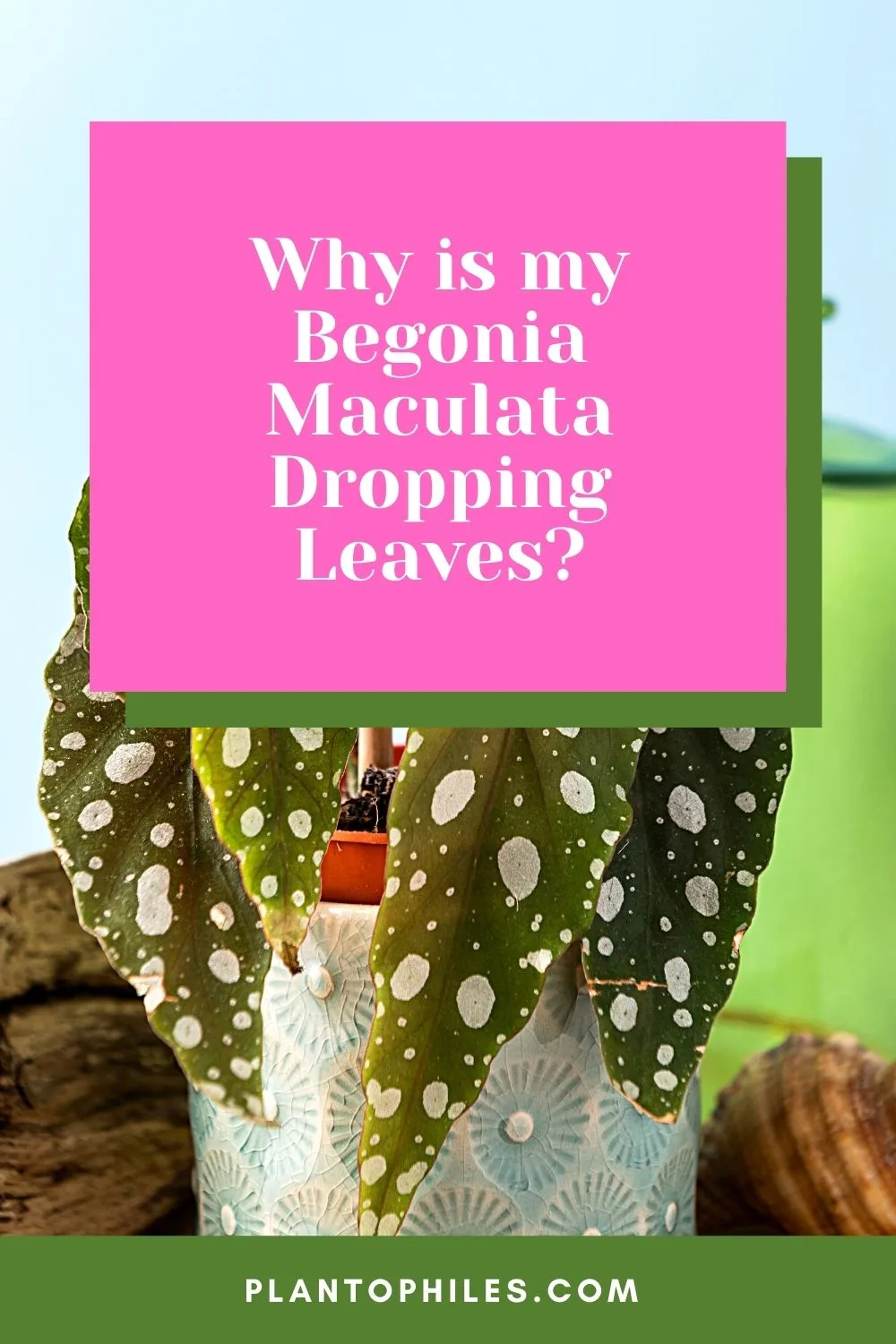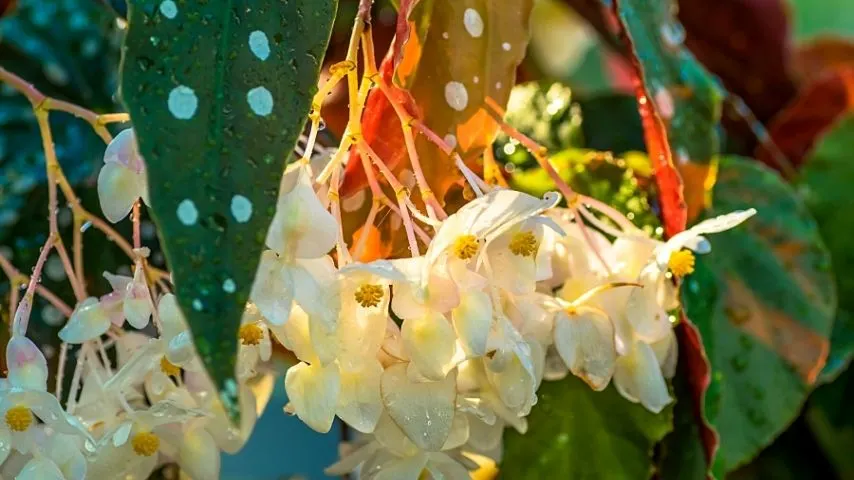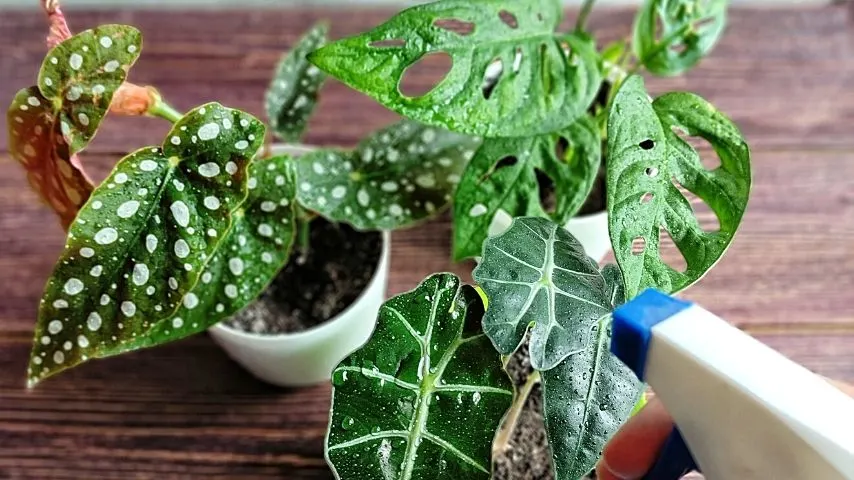Why is my Begonia Maculata Dropping Leaves? Looking at the polka dot pattern on the leaves of this plant, there’s no wonder that the Begonia maculata, or polka dot Begonia, has quickly become a favorite amongst houseplant enthusiasts.
Begonias are called easy and beginner plants according to the University of Vermont.
I can say based on personal experience that the Begonia maculata is an outlier in this regard.
This Begonia can be fussy and leaf drop is one of the most common ways for Begonia maculata to show that it is not happy.
But if those leaves start to drop, it can be a cause for concern.
So, what’s the reason for leaf drop in this particular plant?
This houseplant can be temperamental and leaves dropping is its way of showing that it’s not happy.
The causes are easily remedied though so don’t panic and concentrate on putting things right.
Table of Contents
Why is my Begonia Maculata Dropping Leaves?
The Begonia maculata is dropping leaves because the soil is too wet or too dry and the light the plant receives could be insufficient or too bright. The Begonia maculata is a fussy plant so even the temperature being wrong could cause leaf droppage, especially as this plant likes humidity.

Why is my Begonia Maculata Dropping Leaves?
5 Potential Causes of Leaf Drop in Begonia Maculata
1. Insufficient Light
The Begonia maculata is native to Brazil, usually found in the tropical forests there.
Because of this, this plant is used to the warm and bright sunlight that is to be expected in that climate. However, it can be hard to recreate that tropical weather in your home.

If the Begonia Maculata receives insufficient sunlight, it will begin dropping its leaves
Secure a spot in your house where the plant will get warm and bright indirect sunlight. If the lighting is too harsh, the leaves will start to burn and crisp which will inevitably lead to leaf drop.
It can tolerate lower levels of light if necessary but don’t place it in a dark corner with hardly any light at all.
2. Not Enough Humidity
As I mentioned above, this plant is found in tropical forests where the air is humid.
The ideal place for a plant like this would be a bathroom, where the steam from a shower would recreate the humidity it craves.
But, it’s a fact that not all plant lovers have a room for a rainforest in their bathroom. Instead, mist the plant a couple of times a week with some lukewarm water in a spray bottle.
It doesn’t have to be a fancy plant mister, just a regular spray bottle with a fine nozzle will do the trick.
The mist will keep the leaves moist and they won’t dry out. Once a leaf has dried out, it’ll turn brown and crispy which isn’t ideal for a plant with a stunning leaf pattern.

As the Begonia Maculata is a tropical plant, regularly misting it will help prevent leaf droppage
Regular misting will definitely make your Begonia happier.
3. Incorrect Temperature
Another cause related to the first two but it’s just as important to make sure that this plant is kept at the right temperatures.
It will not tolerate cold and draughty spots. If your Begonia maculata is on a windowsill that lets in the cold from outside, it’s inevitable that it will drop leaves.
Equally, having the plant somewhere too warm will also cause leaf drop as they will start to burn.

Avoid placing your Begonia Maculata in areas with cold drafts or are too warm as the leaves will drop
The good news is that they like the same kind of temperatures we do so it’ll do well indoors.
Keeping it in a climate of above 59°F is ideal but it’ll do best between 65°F and 86°F so maybe think about taking it outside when it’s warmer.
4. Inconsistent Watering
One of the first things you need to remember about this plant is that it’s susceptible to root rot if the soil is too wet.
Therefore, it’s important that you get the watering of this plant perfect otherwise this could lead to problems.
Don’t allow the soil to dry out completely, water it when the first inch or so of soil is dry. Bottom watering, or butt-chugging, is recommended with this plant as it hates its leaves becoming too wet.

If you’re planting your Begonia Maculata in a plot, use the bottom watering technique
Set the pot in a container of water and keep a close eye on it. Remove the pot as soon as the water level has stopped moving.
Optimum leaf health starts with the roots. It’s vital that everything is in great shape under the soil and the roots are getting the correct amount of water and nutrients that the plant needs.
5. Pests
Pests are the pet hate of all houseplant owners. They cause unnecessary amounts of worry and stress, from the minute they’re discovered up until they’re finally eradicated.
The nature of pests is to feed on the plant, sucking the nutrients from the leaves and stems.
Obviously, this is going to lead to leaf drop because the plant doesn’t have enough energy to support itself.
Keep checking your plant for any sign of bugs, fungus growth, or even spots on the leaves. They’re all pretty easy to treat, using treatments found at a local garden center, as long as they’re caught early.
Always remove the damaged leaves or soil to prevent the disease or pests from spreading and isolate the plant until it’s clear.
Frequently Asked Questions about Why Begonia Maculata Drops its Leaves
How do I know if I’ve overwatered my Begonia Maculata plant?
In the case of the polka dot Begonia, look out for soft, mushy leaves and drooping stems. Leave the plant to dry out thoroughly, and you’ll soon see improvements.
Why are my Begonia leaves curling?
This is usually caused by the same reasons as the plant starting to drop leaves. Go through the five points above and correct any issues that you have with your plant. You’ll soon notice improvements in a few days time.
Can you easily care for a Begonia maculata?
To begin with, the polka dot Begonia can seem like a fussy and temperamental plant. But once you have the correct conditions sorted; perfect lighting, temperature, and water, the plant will become pretty easy to look after. You’ll know if it’s happy because it’ll start to grow small white flowers.
Conclusion
While the Begonia maculata has a reputation of being a bit difficult, it’s worth wading through that for the beauty of the leaves.
If your plant has started dropping its spotted leaves, don’t lose faith. Try and remedy the situation and once you’ve figured it out, you’ll fall in love with this plant all over again.

Daniel has been a plant enthusiast for over 20 years. He owns hundreds of houseplants and prepares for the chili growing seasons yearly with great anticipation. His favorite plants are plant species in the Araceae family, such as Monstera, Philodendron, and Anthurium. He also loves gardening and is growing hot peppers, tomatoes, and many more vegetables.


